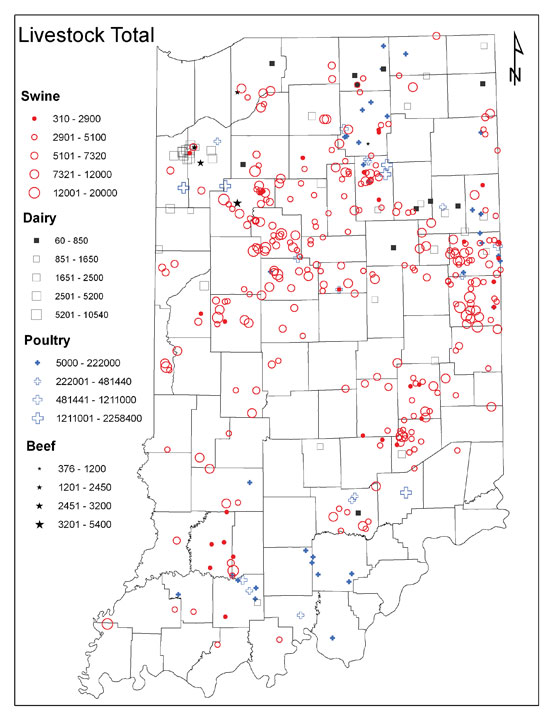Alan Sutton
Animal Sciences
Don Jones
Agricultural & Biological Engineering
Katie Darr
Agricultural Communication
Purdue University
This publication is one title
in the Concentrated Animal Feeding Operations series.
To view the entire series,
visit
http://www.ansc.purdue.edu/CAFO/
|
What is a CFO, CAFO?
Traditional agriculture in the United States looks much different than it used to. Many livestock and crop production farms today are much larger than they were twenty years ago. Agricultural methods are more efficient, produce higher yields, and produce healthier, more wholesome and more affordable foods for human consumption than ever before. With that growth, however, comes new challenges.
New Production Methods
Most livestock producers have adopted new methods of production. Rather than raising animals in outside situations where they are free to roam, they are mostly raised in environmentally controlled housing facilities. This is done not only for efficiencies of labor and land use, but to protect animals from potential diseases and losses from predators.
With large modern livestock and poultry operations, it is common to have separate phases of production located at different locations, often significant distances apart. This is by design and is intended to reduce the threat of disease transmission among groups of animals and improve overall herd or flock health. For example, dairy calves, developing heifers and mature milking cows, may be located at separate locations. Breeding and gestation sows, nursery pigs, and grow-finish pigs are often kept at different locations. Likewise, poultry hatcheries are usually separated from growing birds, and developing beef bulls and heifers may be kept at different locations before entering the beef cow herd.
Agency Definitions
According to the Indiana Department of Environmental Management (IDEM) and the United States Environmental Protection Agency (EPA), an animal production operation is defined as an Animal Feeding Operation (AFO) when: a lot or facility houses animals that “have been, are, or will be stabled or confined and fed or maintained for a total of 45 days or more in any 12-month period. Crops, vegetation, forage growth, or post-harvest residues are not sustained in the normal growing season over any portion of the lot or facility.” In Indiana, an AFO may be further classified as either a Confined Feeding Operation (CFO) or Concentrated Animal Feeding Operation (CAFO), depending on the number of animals housed. The legal authority for this in Indiana is 327 IAC-16 for CFO regulation and 327 IAC-15 for CAFO regulation.
A CFO is defined in Indiana as any animal feeding operation engaged in the confined feeding of at least 300 cattle, or 600 swine or sheep, or 30,000 fowl (chickens, turkeys, or other poultry). These numbers represent all animals that are old enough to be weaned from their mothers or birds of any size and are based on the maximum numbers at any one time on the farm during the year. The regulation governing CFOs was established as a state statute by the legislature in 1971, making Indiana one of the first states in the United States to regulate livestock operations. It has since been converted to a state rule and revised by IDEM to address changing agriculture in the state.
Size Matters
In general, a CAFO is a very large CFO that requires a National Pollutant Discharge Elimination (NPDES) System for discharges or potential discharges of water contimation. However, any animal production unit, regardless of size, that has had a significant pollution discharge or plans to treat manure and discharge treated effluent that meets state water quality standards may be required to obtain an NPDES discharge permit and is defined as a CAFO. In the federal rule of 2003, CAFOs were required to obtain a permit if the operation housed at least 1,000 beef cattle, 700 mature dairy cattle, 1,000 veal calves, 2,500 swine (over 55 lbs), 10,000 swine (less than 55 lbs), 500 horses, 10,000 sheep, 55,000 turkeys, 125,000 chickens (dry systems), 82,000 layers (dry system), 30,000 ducks (dry system), 30,000 chickens or layers (liquid system), and 5,000 ducks (liquid system). As a result of a recent court ruling, however, revisions developed by the EPA rescinded the requirement to apply for an NPDES permit based solely on animal numbers. As of January 2007, approximately 620 of the 2260 CFOs in Indiana were defined as CAFOs.
According to IDEM, the percent of total permitted production operations by species in Indiana are as follows: 70% swine, 8.3% beef, 8.1% dairy, 6.9% chickens, 6.6% turkeys, .04% ducks and .03% sheep. Certain areas in Indiana have a significant concentration of confinement operations. The numbers of CFO operations are highest in Carroll, Clinton, Wabash, Adams, Decatur, Daviess, and Dubois counties. CAFO operations are highest in Kosciusko, Wabash, White, Carroll, Jay, Randolph, and Dubois counties (Figure 1).
|

NEW 7/07
|

Figure 1. CAFO distribution in Indiana.
(Larry Theller, Department of Agricultural and Biological Engineering)
For additional information about confinement operations in Indiana, visit the following websites:
• http://www.in.gov/idem/agriculture/livestock/cfo/index.html
• http://cfpub.epa.gov/npdes/afo/cafofinalrule.cfm.
• http://cfpub.epa.gov/npdes/home.cfm?program_id=7
PURDUE AGRICULTURE
It is the policy of the Purdue University Cooperative Extension Service, David C. Petritz, Director, that all persons shall have equal opportunity and access to the programs and facilities without regard to race, color, sex, religion, national origin, age, marital status, parental status, sexual orientation, or disability. Purdue University is an Affirmative Action institution.
This material may be available in alternative formats.
1-888-EXT-INFO • http://www.extension.purdue.edu/new |

